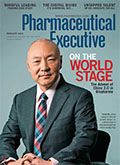Q&A: Regulatory Reform in China
Dr. Lingshi Tan, a director at DIA, and chairman and CEO of Shanghai-based CRO dMed Company Limited, which he founded after establishing R&D operations for Pfizer in China, discusses the nation's regulatory evolution and opportunities for its government to strengthen collaborations with FDA and other leading global agencies.
Dr. Lingshi Tan, a director at the Drug Information Association (DIA), and chairman and CEO of dMed Company Limited, a Shanghai-based contract research organization, recently shared his insights on the impact of regulatory reform in China. Prior to founding dMed, Dr. Tan was Pfizer’s vice president of worldwide development operations and chairman and general manager of Pfizer (China) Research & Development Co., Ltd.
Lingshi Tan

How has the Chinese regulatory environment changed in recent years?
TAN: In just the last three years, China radically altered the regulatory landscape. Even for those of us used to China’s speed of change, the shift in fundamental policy direction, the speed of implementation, and impact on drug development-both in China and globally-has been dramatic.
China formally launched this current phase of regulatory reform on August 18, 2015, when State Council (China’s cabinet) articulated five fresh priorities guiding drug regulation: improve quality of the drug review and approval process, eliminate the review backlog, improve quality of generics, encourage innovation, and increase transparency of the review and approval process.
Since then, action has been swift, bringing China into close alignment with global regulatory practice.
While the range of changes are far-reaching, three stand out as game-changing. First, China cut the time needed to get approval for a clinical trial-which previously could take more than two years-to 60 working days. Second, in June 2017, CFDA became a full regulatory member of ICH and is rapidly issuing guidelines aligned with global practice. Third, in order to support implementation of these changes, the National Medical Products Administration (NMPA) increased the number of reviewers from 200 to more than 600, and is on track to eventually expand this to 2,000.
The full impact of these changes is now being felt. As steady progress is made in implementing the 60-day clinical trial application (CTA) approval target, China can play an integral role in global trials, hastening true global launch of innovative drugs, not just in the US and EU. It also allows sponsors timely access to China’s large pool of treatment-naïve patients, which is of growing importance in crowded therapy areas such as immuno-oncology.
As ICH guidelines become China’s standard, China is increasingly willing to accept global clinical data in support of local product registrations, with priority for products that serve Chinese patients’ unmet medical needs. In fact, in August of last year, the NMPA specifically asked biopharma firms to register 48 foreign drugs that had not yet been introduced in China, and demonstrated its willingness to speed approvals using global data.
The number of CTA approvals is increasing, and the priority review process has already granted 418 applications to date.
Why has China's regulatory approval body had multiple name changes?
TAN: The rapid growth and rising sophistication of the Chinese economy and business environment since reform began in 1978 has been reflected in the evolution of the drug regulatory system. Today, it is hard to imagine that before 1998-just 20 years ago-the entire industry, including drug manufacturing, pricing, and distribution, was managed mainly by state-owned companies under loose guidance from provincial branches of the national Pharmaceutical Administration. Regulatory power only began to centralize when the State Drug Administration was set up in 1998. When food was added to the agency’s responsibilities in 2003, it became the SFDA. As the private sector rose in importance across many sectors of the economy, “state” administrative bodies were renamed to reflect the transition from the old centrally planned economic system. CFDA was born in 2013 to emphasize its growing independence as an industry regulator.
NMPA was created in April 2018. The restructuring reflects the agency’s honed focus on pharmaceuticals and medical devices, versus both food and drugs under the CFDA. Its remit may be expanded to include medical-related artificial intelligence. And we may see further restructuring in 2019 as the regulatory environment continues to evolve. This is simply another example of the speed at which China undergoes change.
What kinds of opportunities are there for China to work with the FDA?
TAN: The US FDA has long played an important role in China’s regulatory evolution. The FDA opened its first office in Beijing in 2008, mainly focused on ensuring the safety and quality of goods, including food, medicines, and medical devices manufactured in China for export to the US. Even earlier, however, US pharmaceutical companies, industry associations, and government agencies, including the FDA, all contributed to an extensive ongoing dialogue with China.
In order for China to develop a world-class biopharmaceutical industry, NMPA urgently needs to further improve and strengthen its regulatory capabilities. The US FDA represents the “gold standard” for world-class expertise and systematic scientific product review and approval that China’s NMPA seeks to emulate. Recent reforms demonstrate NMPA has already adopted many elements of the US FDA system and practice. A steady stream of Chinese CDE (Center for Drug Evaluation) reviewers go for training with the FDA. And many of NMPA’s recent senior hires are scientists with years of experience at FDA.
Increasingly, this has led to sharing review opinions between FDA and CDE and establishing regular communication and information exchanges. The foundations are now in place for the two agencies to systematically share reviewed data and opinions. NMPA will also play a more active role in ICH, helping to drive global regulatory harmonization and strengthen collaboration with FDA and other leading agencies such as EMA and JPMA.
How do you think this collaboration will evolve in the next five years in regard to goals and focus?
TAN: Now that key components of the foundation are in place, increased collaboration seems inevitable. As China eventually overtakes the US to become the world’s largest drug market and as innovative Chinese biopharma companies move on to the global stage, NMPA aspires to be one of the world’s leading regulatory agencies, working in close partnership with counterparts in the US, Europe, and Japan.
Over the next five years, I anticipate further deepening of the progress that has already begun. While each nation will maintain its regulatory independence in approving products for its own market, China and the US can both benefit from further strengthening the communication mechanisms through which both agencies regularly share and exchange evaluation opinions and conclusions in support of their independent product approvals.
Training and talent development in regulatory science will be required to build advanced regulatory capabilities in China, and the US will continue to be the best source of leadership in this area.
As communication and the exchange of staff build further trust, we may begin to see operational cooperation, including strengthening collaboration on real-world evidence to support product approvals. Ideally, we may reach a stage where mutual acceptance of specific tasks-such as GCP inspections-occur.
Finally, I would anticipate deepening collaboration on ICH to further develop ICH guidelines and promote global harmonization. This could eventually move us toward a world in which multinational advisory panels are created to support simultaneous approvals across multiple markets.

Navigating Distrust: Pharma in the Age of Social Media
February 18th 2025Ian Baer, Founder and CEO of Sooth, discusses how the growing distrust in social media will impact industry marketing strategies and the relationships between pharmaceutical companies and the patients they aim to serve. He also explains dark social, how to combat misinformation, closing the trust gap, and more.
FDA Grants Priority Review to Regeneron’s Eylea for Macular Edema Following Retinal Vein Occlusion
April 18th 2025Regulatory action was based on data from the Phase III QUASAR trial, which demonstrated that Eylea HD dosed every eight weeks achieved non-inferior visual acuity outcomes compared to Eylea in patients with macular edema following retinal vein occlusion.